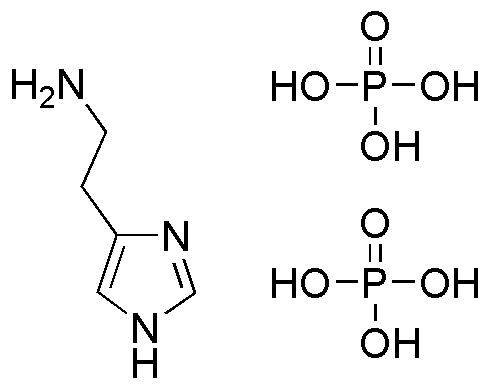Histamine diphosphate salt is widely utilized in research focused on:
- Pharmaceutical Development: It serves as a key ingredient in the formulation of antihistamines, aiding in the treatment of allergic reactions and asthma.
- Neuroscience Research: This compound is used to study neurotransmitter systems, particularly in understanding the role of histamine in brain function and behavior.
- Immunology: Researchers employ it to investigate immune responses, particularly how histamine influences inflammation and allergic reactions.
- Diagnostic Tools: It is utilized in assays and tests to measure histamine levels in biological samples, providing insights into various health conditions.
- Food Industry: The compound is explored for its potential in food preservation and safety, particularly in controlling microbial growth.
Información general
Propiedades
Seguridad y normativas
Aplicaciones
Histamine diphosphate salt is widely utilized in research focused on:
- Pharmaceutical Development: It serves as a key ingredient in the formulation of antihistamines, aiding in the treatment of allergic reactions and asthma.
- Neuroscience Research: This compound is used to study neurotransmitter systems, particularly in understanding the role of histamine in brain function and behavior.
- Immunology: Researchers employ it to investigate immune responses, particularly how histamine influences inflammation and allergic reactions.
- Diagnostic Tools: It is utilized in assays and tests to measure histamine levels in biological samples, providing insights into various health conditions.
- Food Industry: The compound is explored for its potential in food preservation and safety, particularly in controlling microbial growth.
Documentos
Hojas de datos de seguridad (HDS)
La SDS proporciona información de seguridad completa sobre la manipulación, el almacenamiento y la eliminación del producto.
Especificación del producto (PS)
La PS proporciona un desglose completo de las propiedades del producto, incluida la composición química, el estado físico, la pureza y los requisitos de almacenamiento. También detalla los rangos de calidad aceptables y las aplicaciones previstas del producto.
Certificados de análisis (COA)
Busque certificados de análisis (COA) ingresando el número de lote del producto. Los números de lote y de partida se pueden encontrar en la etiqueta de un producto después de las palabras "Lote" o "Lote".
Número de catálogo
Número de lote/lote
Certificados de origen (COO)
Este certificado de origen confirma el país en el que se fabricó el producto y también detalla los materiales y componentes utilizados en él y si se deriva de fuentes naturales, sintéticas u otras fuentes específicas. Este certificado puede ser necesario para cumplir con las normativas aduaneras, comerciales y regulatorias.
Número de catálogo
Número de lote/lote
Hojas de datos de seguridad (HDS)
La SDS proporciona información de seguridad completa sobre la manipulación, el almacenamiento y la eliminación del producto.
DownloadEspecificación del producto (PS)
La PS proporciona un desglose completo de las propiedades del producto, incluida la composición química, el estado físico, la pureza y los requisitos de almacenamiento. También detalla los rangos de calidad aceptables y las aplicaciones previstas del producto.
DownloadCertificados de análisis (COA)
Busque certificados de análisis (COA) ingresando el número de lote del producto. Los números de lote y de partida se pueden encontrar en la etiqueta de un producto después de las palabras "Lote" o "Lote".
Número de catálogo
Número de lote/lote
Certificados de origen (COO)
Este certificado de origen confirma el país en el que se fabricó el producto y también detalla los materiales y componentes utilizados en él y si se deriva de fuentes naturales, sintéticas u otras fuentes específicas. Este certificado puede ser necesario para cumplir con las normativas aduaneras, comerciales y regulatorias.


